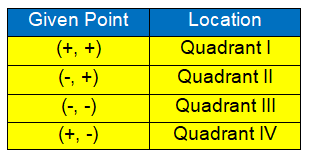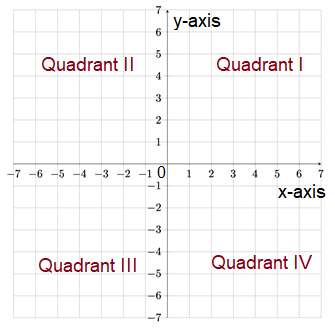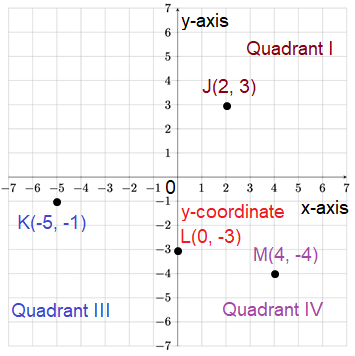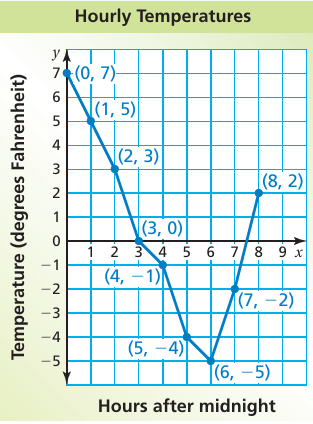IDENTIFYING QUADRANT OF THE COORDINATE POINT LIES
By table,

By graph,

Example 1 :
Describe the location of the point.
|
(i) J(2, 3) (ii) K(-5, -1) |
(iii) L(0, -3) (iv) M(4, -4) |
Solution :

By observing the above graph,
(i) J(2, 3) is located at Quadrant I.
(ii) K(-5, -1) is located at Quadrant III.
(iii) L(0, -3) is located at y-coordinate.
(iv) M(4, -4) is located at Quadrant IV.
Example 2 :
What is the x-coordinate of the point (-12, 7)? What is the y-coordinate?
Solution :
The x-coordinate of the point is -12.
The y-coordinate of the point is 7.
Example 3 :
A point has one positive coordinate and one negative coordinate. Can you determine in which quadrant the point lies? Explain.
Solution :
If the point has one positive coordinate and one negative coordinate that is located at Quadrant IV.
Example 4 :
Give the coordinates of the point.
|
(i) A (ii) B (iii) C (iv) D |
(v) E (vi) F (vii) G (viii) H |

Solution :
By observing the above graph,
The coordinates of Point A are (-4, 2).
The coordinates of Point B are (0, 3).
The coordinates of Point C are (0, 0).
The coordinates of Point D are (4, 0).
The coordinates of Point E are (-2, -4).
The coordinates of Point F are (3, 3).
The coordinates of Point G are (4, 4).
The coordinates of Point H are (-3, -2).
Example 5 :
Use the variable expression 2x + 1.
a) Evaluate the expression when x = -3, -2, -1, 0, 1, 2, and 3
b) Use your results from part (a) to write a list of ordered pairs in the form (x, 2x + 1).
Solution :
a)
Given, expression 2x + 1
|
when x = -3 = 2(-3) + 1 = -6 + 1 = -5 |
when x = -2 = 2(-2) + 1 = -4 + 1 = -3 |
when x = -1 = 2(-1) + 1 = -2 + 1 = -1 |
|
when x = 0 = 2(0) + 1 = 0 + 1 = 1 |
when x = 1 = 2(1) + 1 = 2 + 1 = 3 |
when x = 2 = 2(2) + 1 = 4 + 1 = 5 |
|
when x = 3 = 2(3) + 1 = 6 + 1 = 7 |
b)
write a list of ordered pairs in the form (x, 2x + 1)
From (a),
|
(-3, -5) (-2, -3) (-1, -1) (0, 1) |
(1, 3) (2, 5) (3, 7) |
Example 6 :
A blizzard hits a town at midnight. The table shows the hourly temperatures from midnight to 8:00 A.M.

a) Display the data in a line graph.
b) Make three observations from the graph.
Solution :
a) Write the ordered pairs. (0, 7) (3, 0) (1, 5) (4, –1) (2, 3) (5, −4) (6, −5) (7, −2) (8, 2) Plot and label the ordered pairs. Then connect the ordered pairs with line segments.
b)

Three possible observations follow:
● The hourly temperatures decrease from midnight to 6:00 a.m.
● The hourly temperatures increase from 6:00 a.m. to 8:00 a.m.
● The greatest decrease in hourly temperatures from one hour to the next is 3°F. This happens twice: from 2:00 a.m. to 3:00 a.m. and from 4:00 a.m. to 5:00 a.m.
Example 7 :
How many quadrants are in a coordinate plane?
Solution :
There are four quadrants.
Example 8 :
Is the point (0, −7) on the x-axis or the y-axis?
Solution :
When the input is 0, the point is on the y-axis.
Example 9 :
Which point does not belong with the other three? Explain your reasoning. (−2, 1) (−4, 5) (2, −3) (−1, 3)
Solution :
The points in the coordinate plane will be in the form :
|
|
So, the point (2, -3) is not belongs to the group.
Example 10 :
Describe the possible location(s) of the point (x, y).
a) x > 0, y > 0
b) x < 0, y < 0
c) x > 0, y < 0
d) x > 0
e) y < 0
f) x = 0, y = 0
Solution :
a) x > 0, y > 0
The point will be in the form (x, y). So, the required point will be in the first quadrant.
b) x < 0, y < 0
The point will be in the form (-x, -y). So, the required point will be in the third quadrant.
c) x > 0, y < 0
The point will be in the form (x, -y). So, the required point will be in the fourth quadrant.
d) x > 0
The point will be in the forms (x, y) or (x, -y). So, the required point will be in the first quadrant or fourth quadrants.
e) y < 0
The point will be in the form (x, -y) or (-x, -y). So, the required point will be in the first quadrant and third quadrants,
f) x = 0, y = 0
The point (0, 0) is at orgin.
Recent Articles
-
Finding Range of Values Inequality Problems
May 21, 24 08:51 PM
Finding Range of Values Inequality Problems -
Solving Two Step Inequality Word Problems
May 21, 24 08:51 AM
Solving Two Step Inequality Word Problems -
Exponential Function Context and Data Modeling
May 20, 24 10:45 PM
Exponential Function Context and Data Modeling